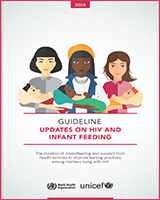- Antiretroviral (ARV) drug
the medicine used to treat HIV infection.
- Antiretroviral therapy (ART)
the use of a combination of three or more ARV drugs for treating HIV infection. ART involves lifelong treatment.
- ARV drugs for HIV prevention
ARV drugs for the prevention of HIV transmission and includes ARV drugs given to the mother or infant for preventing mother-to-child transmission of HIV, ARV drugs to reduce the transmission of HIV among serodiscordant couples and ARV drugs to prevent people from acquiring HIV when they are exposed (post-exposure and pre-exposure prophylaxis).
- Exclusive breastfeeding
the infant receives only breast milk without any other liquids or solids, not even water, except for oral rehydration solution or drops or syrups of vitamins, minerals or medicines.
- HIV
the human immunodeficiency virus. There are two types of HIV HIV-1 and HIV-2. The vast majority of people living with HIV infections globally have HIV-1.
- HIV-exposed infant or child
an infant or child born to a mother living with HIV until the infant or child is reliably excluded from being HIV infected.
- HIV-free survival
an infant or young child born to a mother living with HIV remains both HIV uninfected (confirmed negative HIV status) and also alive over a defined follow-up period. It is commonly reported at 18 months or 24 months of age.
- Mixed feeding
an infant younger than six months of age is given other liquids and/or foods together with breast milk. This could be water, other types of milk or any type of solid food.
- Neonate
an infant 0–28 days old.
- Postnatal transmission
transmission of HIV to an infant or child after birth. Most postnatal transmission is through the breast milk of a woman living with HIV, but this also includes accidental infection, such as through an infected needle or through child abuse.
- Prevention of mother-to-child transmission of HIV
previous WHO guidelines have used the terms “options A, B and B+” to refer to different approaches to preventing the mother-to-child transmission of HIV. The 2013 WHO consolidated guidelines on the use of ARV drugs recommended one of two approaches: (1) providing ART during pregnancy and breastfeeding to women who are otherwise not eligible for ART (option B); or (2) providing lifelong ART to all pregnant and breastfeeding women living with HIV regardless of CD4 count or clinical stage (option B+).
- Public health approach
addresses the health needs of a population or the collective health status of the people rather than focusing primarily on individual case management. This approach aims to ensure the widest possible access to high-quality services at the population level, based on simplified and standardized approaches, and to strike a balance between implementing the best-proven standard of care and what is feasible on a large scale in resource-limited settings. For HIV, key elements of a public health approach include simplified drug formularies; large-scale use of fixed-dose combinations; care and drugs provided free of charge at the point of service delivery; decentralization and integration of services, including task shifting; and simplified approaches to clinical monitoring.
- Replacement feeding
feeding an infant who is not receiving any breast milk with a diet that provides all the nutrients children need until they can be fully fed on family foods. During the first six months, this should be with a suitable breast milk substitute: commercial infant formula milk. After six months, it should preferably be with a suitable breast milk substitute and complementary foods made from appropriately prepared and nutrient-enriched family foods given three to five times per day.
- Treatment failure
the current WHO virological criterion for treatment failure is a viral load of 1000 copies per ml or more.
- Universal access to ART
defined broadly as a high level of access (80% or more of the eligible population) that is affordable. It does not necessarily mean 100% coverage.
- Vertical transmission
transmission of HIV that occurs from a mother living with HIV to her infant. This may occur in utero, in the peripartum period or postnatally through breastfeeding.
- Viral failure
the inability to achieve or maintain viral suppression below a certain threshold.
- Viral suppression
a viral load below the detection threshold using viral assays.

